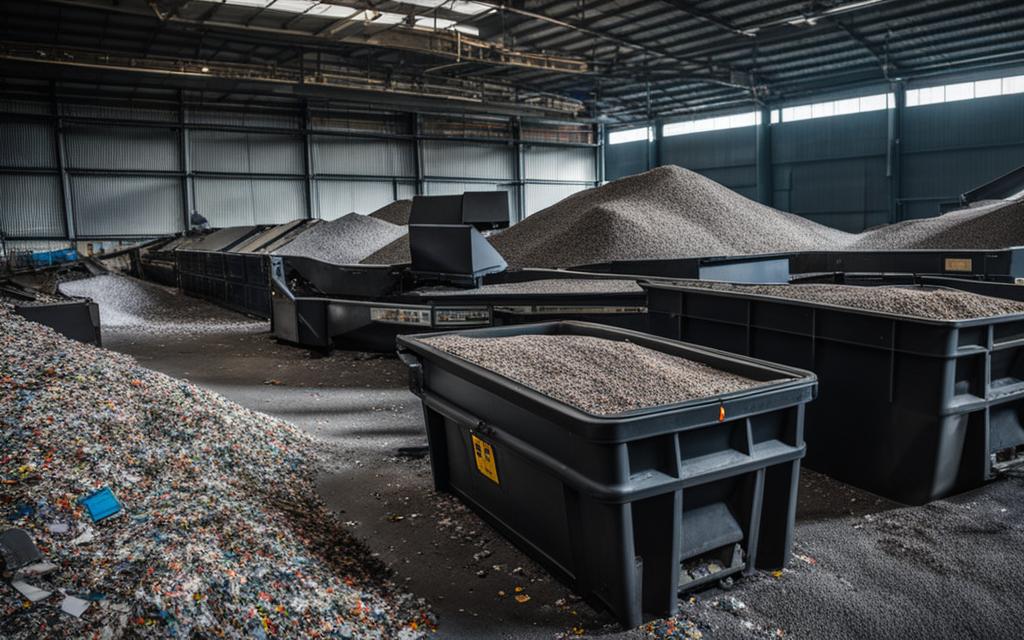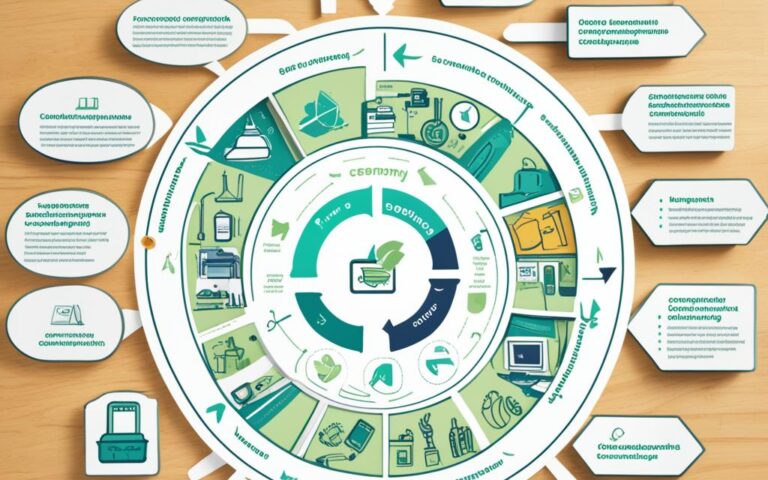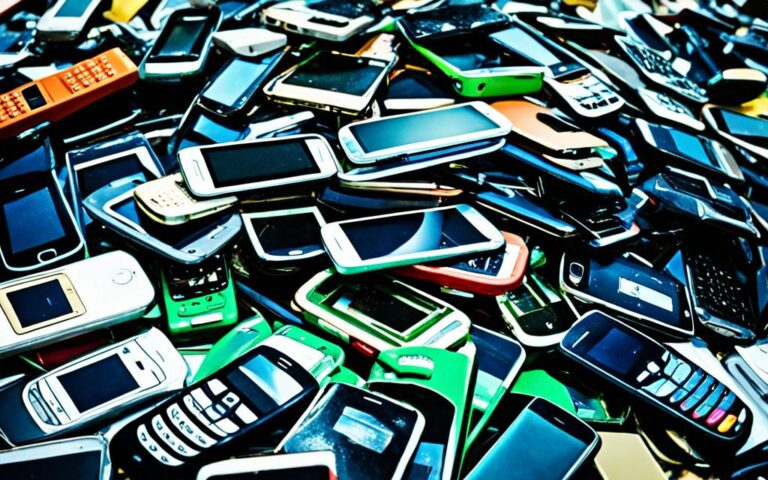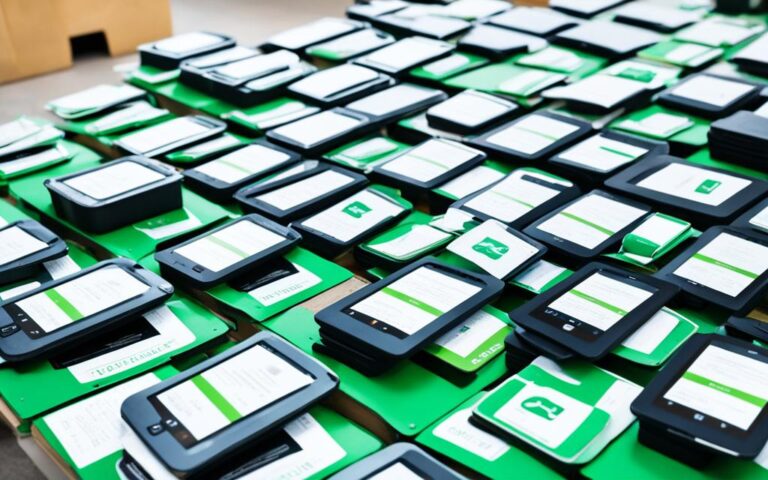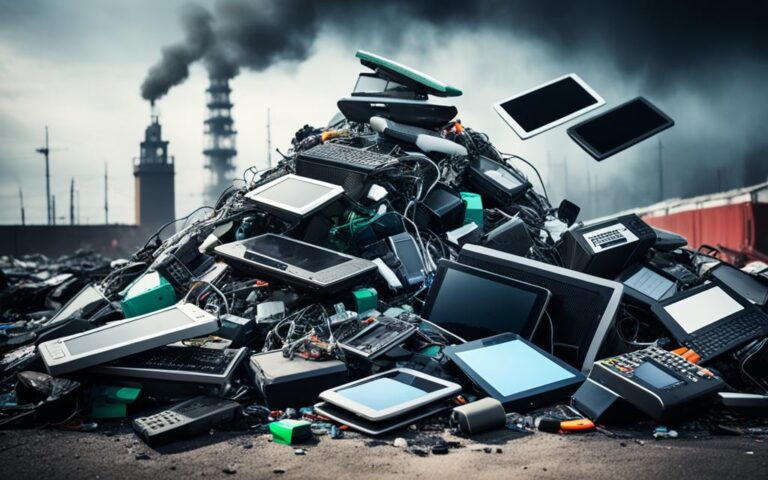Tablet Recycling: Legal and Regulatory Considerations
Welcome to an inspiring journey of tablet recycling, where we explore the legal considerations and regulatory requirements that ensure a sustainable future for our electronic waste. In this section, we will dive into the California Electronic Waste Recycling Act of 2003, a groundbreaking law that sets the stage for responsible tablet disposal.
Did you know that tablets, those versatile devices we rely on for work, entertainment, and connection, are considered covered electronic devices under this law? This means that they are subject to specific regulations and requirements aimed at reducing the environmental impact of their disposal.
The California Electronic Waste Recycling Act is implemented by CalRecycle along with the Department of Toxic Substances Control (DTSC) and the California Department of Tax and Fee Administration (CDTFA). To drive sustainable practices, a fee is collected by retailers in California at the point of sale of a covered electronic device, including tablets. These funds are then used to support the collection and recycling of electronic waste.
Recyclers and collectors of covered electronic devices, including tablets, receive payments from CalRecycle to offset the cost of recovery, processing, and recycling activities. It’s incredible to see how this visionary law not only encourages responsible disposal but also fosters a vibrant recycling ecosystem.
So, let’s embark on this voyage together. In the following sections, we will explore the different aspects of tablet recycling regulations, uncovering the importance of proper disposal, the broad definition of covered electronic devices, and the future of electronic waste management. Join us on this path towards a greener, more sustainable world.
Covered Electronic Devices Under California Law
Under California law, covered electronic devices include video display devices with screens greater than four inches, including cathode ray tube (CRT) and liquid crystal display (LCD) televisions and monitors, laptop computers, tablets, and portable DVD players. These devices are identified as hazardous waste when discarded by the Department of Toxic Substances Control (DTSC).
The Quarterly Update on California’s CEW Recycling Program provides statistics and further information about the program. Retailers in California collect a recycling fee from consumers at the point of sale, and these fees are used to fund the collection and recycling of covered electronic devices. The funds are deposited into the EWRRA and distributed to approved recyclers and collectors. The current consumer fees for tablets range from £4 to £6, depending on the screen size.
Did you know that tablets, along with other electronic devices, are considered covered electronic devices under California law? This means that when they are discarded, these devices are classified as hazardous waste. To tackle this issue and promote responsible disposal, California has implemented a comprehensive recycling program specifically designed for covered electronic devices.
When it comes to covered electronic devices, the key focus is on recycling and proper disposal. The state has set up a recycling fee that is collected from consumers at the point of sale by retailers. These fees play a vital role in funding the collection and recycling efforts of approved recyclers and collectors. By introducing such a recycling program, California aims to minimize the environmental impact of electronic waste and ensure its safe and sustainable management.
By participating in the recycling program, consumers not only fulfill their legal obligations but also contribute to the reduction of hazardous waste and the preservation of the environment. The program not only applies to tablets but also extends to other covered electronic devices, including televisions, monitors, laptops, and portable DVD players.
With the rising popularity of tablets and other electronic devices, it is essential to raise awareness about the importance of their proper disposal. Recycling these devices not only prevents hazardous materials from entering landfills but also allows for the recovery of valuable resources. Through the recycling program, California is taking a proactive approach towards electronic waste management and striving for a more sustainable future.
Regulations and Statutes for Electronic Waste Disposal
When it comes to the disposal of electronic waste, including tablets, there are important regulations and statutes that must be followed. These regulations exist at both federal and state levels to ensure the proper management of hazardous materials present in electronic devices.
At the federal level, the Resource Conservation and Recovery Act (RCRA) plays a significant role in regulating electronic waste disposal. This act sets guidelines and standards for the safe handling, storage, and disposal of hazardous wastes, including electronic devices.
On the state level, California has implemented regulations through the Health and Safety Code to address the proper disposal of electronic waste. These regulations are detailed in the California Code of Regulations (CCR), specifically in Title 14, Division 7, and were established to implement the Electronic Waste Recycling Act of 2003.
The Department of Toxic Substances Control (DTSC) is responsible for overseeing and enforcing the physical management of e-waste in California. They work to ensure that electronic waste is handled and disposed of in a manner that minimizes harm to the environment and public health.
Specific statutes, such as SB 1215, further outline the legal requirements and responsibilities for the proper disposal of electronic waste. These statutes help guide individuals and businesses in navigating the complex landscape of e-waste disposal, ensuring compliance with the law.
To address the ever-evolving challenges of electronic waste disposal, various emergency regulations and proposed regulations have been approved. These measures aim to address specific aspects of electronic waste recycling in California, such as improving collection methods, enhancing recycling processes, and promoting the safe disposal of hazardous materials.
Overview of Electronic Waste Disposal Regulations
| Regulation | Description |
|---|---|
| Resource Conservation and Recovery Act (RCRA) | Federal regulations governing the disposal of hazardous wastes, including electronic waste. |
| California Code of Regulations (CCR) | State regulations in Title 14, Division 7, that implement the Electronic Waste Recycling Act of 2003. |
| Health and Safety Code | State regulations governing the proper disposal of electronic waste in California. |
| SB 1215 | A specific statute outlining legal requirements and responsibilities for electronic waste disposal in California. |
These regulations and statutes not only ensure the safe and environmentally friendly disposal of electronic waste but also promote responsible practices that contribute to a sustainable future. By adhering to these guidelines, individuals and businesses can actively participate in the movement towards a greener and cleaner world.
Disposal of Controlled Substances and Prescription Drugs
The disposal of dispensed controlled substances and prescription drugs is subject to regulations and legal considerations in order to prevent abuse, protect public health, and avoid environmental harm. Proper disposal methods are encouraged to prevent the accessibility and availability of prescription drugs for non-medical purposes.
“Proper disposal methods play a crucial role in safeguarding public health and the environment. It is essential to prevent the diversion of controlled substances and the misuse of prescription drugs.”
Local communities and states have implemented pharmaceutical disposal programs, also known as drug “take-back” programs, to collect unused and unwanted medications for safe disposal. These programs provide convenient and secure options for individuals to dispose of their prescription drugs responsibly.
Controlled substances are subject to the federal Controlled Substances Act, which generally prohibits the transfer of controlled substances for any purpose, including disposal. However, legislation such as the Secure and Responsible Drug Disposal Act of 2010 has allowed for the disposal of controlled substances in compliance with regulations issued by the Attorney General.
In addition to federal regulations, individual states may have specific disposal requirements for controlled substances and prescription drugs. It is important to consult local regulations and guidelines to ensure proper compliance with disposal regulations.
Pharmaceutical Disposal Programs
Pharmaceutical disposal programs, commonly known as drug “take-back” programs, provide a safe and convenient way for individuals to dispose of their unused or expired medications. These programs are typically organized by local law enforcement agencies, pharmacies, or other authorized entities.
Here are some key benefits of participating in a drug “take-back” program:
- Promotes public safety by reducing the risk of accidental ingestion or misuse of prescription drugs
- Prevents medications from contaminating water sources or entering the environment
- Reduces the likelihood of prescription drugs falling into the hands of individuals who may misuse or abuse them
By participating in drug “take-back” programs, individuals can contribute to the overall efforts in combating the opioid epidemic, protecting public health, and preserving the environment.
Disposal Methods for Home Use
If a drug “take-back” program is not readily available, there are a few guidelines for the safe disposal of controlled substances and prescription drugs at home:
- Follow any specific disposal instructions provided by the pharmacist or healthcare provider.
- If no instructions are available, mix the medications with an undesirable substance, such as coffee grounds or kitty litter, in a sealed bag or container before disposing of them in the trash. This helps ensure that the medications are less likely to be accidentally consumed or misused.
- Remove and destroy any personal identifiable information from the prescription medicine containers before disposing of them.
- Do not flush prescription drugs down the toilet or drain unless specific instructions advise doing so. Flushing medications can contaminate water sources and harm the environment.
It is important to note that these methods may not be suitable for all types of medications. Certain medications, especially those classified as hazardous substances, may require specific disposal methods. Contact your local pharmacy, healthcare provider, or waste management agency for guidance on proper disposal.
Comparison of Disposal Methods for Controlled Substances and Prescription Drugs
| Disposal Method | Advantages | Disadvantages |
|---|---|---|
| Pharmaceutical Disposal Programs | Secure and convenient | Availability and accessibility may vary |
| Disposal at Home (with undesirable substances) | Convenient for immediate disposal | Not suitable for all medications and may still pose risks if not properly secured |
| Flushing (if specific instructions advise doing so) | Immediate disposal | Potential environmental impact |
Remember, it is crucial to follow specific disposal instructions provided by healthcare professionals or local regulations to ensure the safe and responsible disposal of controlled substances and prescription drugs.
Future of Electronic Waste Management in California
In order to address the evolving landscape of electronic devices and the need for comprehensive e-waste management, CalRecycle initiated the Future of Electronic Waste project in 2016. The project aims to evaluate the current e-waste recycling conditions and develop recommendations for the future management of e-waste in California.
Key recommendations include:
- Adding more devices to the definition of covered electronic devices
- Increasing public education and outreach
- Strengthening manufacturer responsibilities
- Promoting repair and reuse of electronic devices
- Initiating research on new recycling technologies
- Considering changes to the fee collection and payment system
CalRecycle has engaged stakeholders throughout the project to gather input and ensure a collaborative approach to the future of e-waste management in the state.
Programmatic Models for E-Waste Recycling
E-waste recycling is a pressing concern in today’s technology-driven world. As the volume of electronic waste continues to grow, it is crucial to explore programmatic models that can effectively address this environmental challenge. The Future of Electronic Waste project in California has been at the forefront of investigating different approaches to e-waste recycling and management.
One programmatic model involves enhancing the existing fee and payment program. This model builds upon the current system by implementing improvements that streamline the collection and recycling process. By increasing efficiency and effectiveness, this model aims to maximize the recovery of valuable materials from electronic devices, including tablets, while minimizing the environmental impact.
Another potential model is transitioning to a full extended producer responsibility (EPR) approach. This approach shifts the responsibility of e-waste management onto the manufacturers and encourages them to take a proactive role in the entire lifecycle of their products. By holding manufacturers accountable for the end-of-life disposal of their electronic devices, this model seeks to promote sustainable production practices and reduce the burden on consumers and local governments.
The third programmatic model under consideration is a hybrid model that combines elements of both the fee and payment program and extended producer responsibility. This approach strives to leverage the strengths of both models and create a comprehensive framework for e-waste recycling. By striking a balance between industry accountability and consumer convenience, this model aims to optimize the collection and recycling of electronic devices.
Incentives for Repair and Reuse
A key aspect of programmatic models for e-waste recycling is incentivizing repair and reuse. By encouraging consumers to seek repairs for their electronic devices instead of immediate disposal, valuable resources can be conserved and unnecessary waste can be avoided. Additionally, promoting the reuse of electronic devices extends their lifespan and reduces the demand for new products, thereby reducing the overall environmental impact.
“Incentivizing repair and reuse helps create a culture of sustainability and responsible consumption within the electronics industry.” – John Green, Environmental Advocate
Several states and countries have implemented extended producer responsibility (EPR) models that effectively incentivize repair and reuse. These models offer financial incentives or discounts on future purchases to consumers who opt for repairs instead of replacing their electronic devices. By providing tangible benefits for sustainable consumer choices, these models encourage the preservation of valuable resources and contribute to a circular economy.
Stakeholder Input and Legislative Considerations
The final decision on the programmatic model for e-waste recycling in California will require thorough consideration of stakeholder input, the effectiveness of the current system, and the overarching goals of comprehensive e-waste management. Engaging stakeholders, including manufacturers, consumers, environmental organizations, and recycling industry experts, ensures a collaborative approach that considers diverse perspectives and expertise.
New legislation will be necessary to implement the chosen programmatic model effectively. This legislation should reflect the input and recommendations of stakeholders and address the intricate legal and regulatory aspects of e-waste recycling. By establishing clear guidelines and responsibilities, the legislation can provide a solid framework for long-term success in sustainable e-waste management.
The Path to Comprehensive E-Waste Management
E-waste recycling is not only an environmental imperative but also an opportunity to harness innovative solutions for a greener future. By adopting programmatic models that emphasize extended producer responsibility, incentivize repair and reuse, and integrate stakeholder input, California can pave the way towards comprehensive e-waste management.
The image above highlights the importance of responsible e-waste recycling and the need for effective programmatic models to tackle this growing issue. By embracing these models, California can lead the way in sustainable electronic waste management and contribute to a cleaner, healthier planet.
Conclusion
Tablet recycling regulations are essential in ensuring the eco-friendly and compliant disposal of electronic waste. The California Electronic Waste Recycling Act of 2003, along with other regulations, establishes a comprehensive system for the collection and recycling of covered electronic devices, including tablets. This program is funded through a recycling fee collected at the point of sale, which supports the efforts of approved recyclers and collectors in responsibly managing electronic waste.
Proper disposal of controlled substances and prescription drugs is also crucial to prevent abuse and protect public health. By adhering to regulations and implementing safe disposal methods, we can minimize the accessibility of prescription drugs and reduce environmental harm. These efforts align with the larger green revolution, where individuals and organizations are striving towards sustainable practices in electronic waste management.
Looking to the future, it is crucial to expand the definition of covered electronic devices, promote repair and reuse, and explore innovative recycling technologies. This will further enhance e-waste management in California and contribute to a more sustainable future. By embracing these tablet recycling regulations and adopting eco-friendly disposal practices, we can play an active role in driving the green revolution and ensuring the long-term sustainability of electronic waste management.
FAQ
What is the California Electronic Waste Recycling Act of 2003?
The California Electronic Waste Recycling Act of 2003 sets up a system for the collection and recycling of certain electronic wastes, including tablets.
What are covered electronic devices under California law?
Covered electronic devices include video display devices, laptops, tablets, and portable DVD players.
Are tablets considered hazardous waste?
Yes, tablets are considered hazardous waste when discarded.
How are covered electronic devices collected and recycled?
A recycling fee is collected at the point of sale, and the funds are used to support the collection and recycling activities of approved recyclers and collectors.
Are there regulations for the disposal of controlled substances and prescription drugs?
Yes, there are regulations in place to prevent abuse and protect public health during the disposal of controlled substances and prescription drugs.
What is the Future of Electronic Waste project in California?
The Future of Electronic Waste project aims to evaluate the current e-waste recycling conditions and develop recommendations for the future management of e-waste in California.
What are the programmatic models for e-waste recycling?
The programmatic models include enhancing the existing fee and payment program, transitioning to a full extended producer responsibility (EPR) approach, or developing a hybrid model that combines aspects of both.
Why is tablet recycling important?
Tablet recycling is important to ensure eco-friendly and compliant disposal of electronic waste, contributing to a sustainable future for electronic waste management.

